分子生物学基本概念
现代分子生物学课件
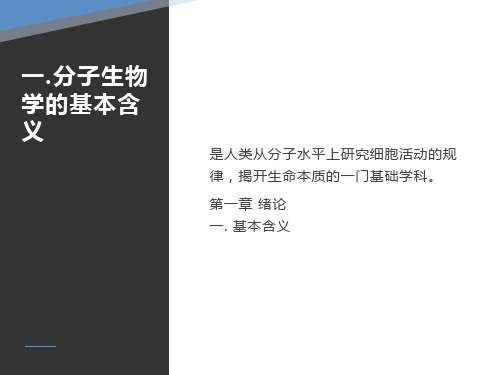
分子生物学的建立和发展阶段 主要进展: 50年代提出了DNA分子的双螺旋结构模型和半保留复制机制, 解决了遗传物质的自我复制和世代交替问题; 50年代末至60年代, 提出了“中心法则”和操纵子学说, 成功地破译了遗传密码, 阐明了遗传信息的流动与表达机制。 P. 11
2.主要研究内容
#2022
分子生物学的研究内容 DNA重组技术
(1)DNA 重组技术(基因工程/遗传工程/基因操作/基因克隆/分子克隆) 在体外将不同的 DNA 片段 (整个基因或基因的 一个部分) 按照人们的设计定向连接起来后,转入 特定的受体细胞,使重组基因在受体细胞中与载体 同时复制并得到表达,从而赋予生物体新的遗传特 性, 创造出更符合人们需要的新的生物类型和生物 产品。
DNA重组操作主要包括: DNA (基因组和质粒DNA) 提取和纯化 PCR (聚合酶链反应) 基因扩增 DNA聚合酶 DNA分子切割 限制性内切酶 DNA片段与载体连接 DNA连接酶 DNA凝胶电泳 细胞转化及重组子的筛选与鉴定等
பைடு நூலகம்
构成生物体各类有机大分子的单体在不同生物中
分子生物学的基本原理 (p 11)
生物体内一切有机大分子的建成都遵循共同的规
都是相同的。
某一特定生物体所拥有的核酸及蛋白质分子决定
则。
单击此处添加正文,文字是您思想的提炼,请尽量言简意赅地阐述观点。
了它的属性。
第一章 绪论 三. 主要研究内容
分子水平是指 携带遗传信息的核酸和在遗传信息传递及细胞内、细胞间通讯过程中发挥着重要作用的蛋白质等生物大分子。 分子水平上研究生命的本质主要是指 对遗传、生殖、生长和发育等生命基本特征的分子机理的阐明, 从而为利用和改造生物奠定理论基础和提供新的手段。
分子生物学第一章绪 论

Avery 在1944年更精密的实验设计
• 提取可能的转化因子:DNA、RNA、蛋白质、荚膜进行试 验
• 分别用降解DNA、RNA、蛋白质的酶作用于S型菌细胞抽 提物
• 组分提纯试验结果:DNA组分纯度越高,转化效率越高。
结论:使R型菌变为S型菌的物质是S型菌的DNA
• Avery在1944年的报告中这样写道:当溶 液中酒精的体积达到9/10时,有纤维状物 质析出;如稍加搅动,这种物质便会像棉 线绕在线轴上一样绕在硬棒上,溶液中的 其他成分则以颗粒状沉淀留在下面。溶解 纤维状物质并重复沉淀数次,可提高其纯 度。这一物质具有很强的生物学活性,初 步实验证实它很可能就是DNA。
4.假基因 不能合成出功能蛋白质的失活基因 。
5.重叠基因 不同基因的核苷酸序列有时是可以共用的 即重叠 的。
1983年,McClintock由于在50年代提出并发 现了可移动遗传因子(jumping gene或称 mobile element)而获得Nobel奖。
Barbra McClintock
• 阐明这些复杂的结构及结构与功能的关系是分子生 物学的主要任务。
一、基因的发展
1. Mendel的遗传因子阶段 2. 摩尔根的基因阶段 3. 顺反子阶段 4. 现代基因阶段
Mendel的遗传因子阶段
• Mendel提出:生物的某种 性状是由遗传因子负责传 递的。是颗粒性的,体细 胞内成双存在,生殖细胞 内成单存在。遗传因子是 决定性状的抽象符号。
T2噬菌体感染试验 (1952年,Hershey & Chase)
病毒重建试验
杂种病毒的感染 特征和蛋白质外 壳的特性是由其 中的RNA决定的, 而不是蛋白质决
定的
结论
分子生物学概述

传信息传递的基本方式,最终确
定了核酸是遗传的物质基础。
5’
2、遗传信息传递中心法则的建立
1956年,Kornber在大肠杆菌的无细胞提取液中实
现了DNA的合成,并从E.col中分离出DNA聚合酶;
1958年,Meselson与Stahl的实验证明,DNA复制 时 DNA分子的两条链先行分开。他们用15N重同位 素及密度梯度超速离心证明了DNA的复制是一种半 保 留复制。
三、分子生物学的主要研究内容
1、重组技术的建立和发展 2、基因组研究的发展 3、功能基因组研究的发展 4、基因表达调控机理的研究
基因组、功能基因组及生物信息学研究
基因组:指某种生物单倍体染色体中所含有基因的总数, 也就是包含个体生长、发育等一切生命活动所需的全部 遗传信息的整套核酸。
功能基因组:又称后基因组,是在基因组计划的基础上 建立起来的,它主要研究基因及其所编码蛋白质的结构 和功能,指导人们充分准确地利用这些基因的产物。
人类基因组计划(human genome project, HGP)
美国科学家、诺贝尔奖获得者Dulbecco R于1986年在美国 《 Science 》杂志上发表的短文中率先提出,并认为这是加快 癌症研究进程的一条有效途径。
主要的目标是绘制遗传连锁图、物理图、转录图,并完成人类 基因组全部核苷酸序列测定。测出人体细胞中24条染色体上全 部30亿对核苷酸的序列,把所有人类基因都明确定位在染色体 上,破译人类的全部遗传信息。
里程碑的发现
Watson 和 Crick 在前人的基础 上,提出了DNA双螺旋结构的 模型。
1962年诺贝尔医学与生理学奖
Watson JD和Crick FHC的“双
5’
什么是分子生物学

什么是分子生物学分子生物学是一门崭新的科学,由于它是20世纪发展起来的新兴学科,它在未来也将产生重大的影响。
下面将介绍分子生物学的几个基本概念并阐述它的重要性:一、什么是分子生物学?分子生物学是一门研究分子水平生命现象和自然关系的新科学。
它使用分子生物学手段,利用化学、物理和生物技术,探讨以分子和最小细胞为基础的生物学过程。
分子生物学以DNA、RNA、蛋白质和其他分子结构为框架,结合生物信息学,解析各种生物过程及其分子机制。
二、分子生物学的方法分子生物学有许多研究方法和工具,主要包括基因测序、分子标记、克隆技术、蛋白质分析、遗传学和定量PCR的技术。
(1)基因测序:基因测序是分子生物学研究最常用的技术,它是一种可以分析DNA片段顺序和检测DNA表达状态的技术。
(2)分子标记:分子标记是将一种活性体与另一种它可能与之具有共同性质的生物活性体混合,以产生一种可检测的化学反应的技术。
(3)克隆技术:克隆技术是指利用可重组DNA技术在一个宿主上复制目标DNA片段、克隆它们作为载体的技术。
(4)蛋白质分析:蛋白质分析是指利用紫外分光光度计、流式细胞仪等分析仪器,研究蛋白质结构、凝胶电泳分析、质谱分析以及免疫学方法等技术来检测蛋白质结构和性质的方法。
(5)遗传学:遗传学是指研究基因在细胞中的表达、基因间相互作用及其在不同生物间的进化变异,以及它们在适应性演化中的作用的学科。
(6)定量PCR:定量PCR是指使用定量PCR技术研究DNA序列,利用荧光基因特异性引物和特异序列来检测、建库和定量分析DNA。
三、分子生物学的重要性(1)分子生物学能够探究生命的奥秘;(2)通过分子生物学,我们可以更好地了解遗传基因是如何影响人类生理和心理行为;(3)分子生物学可以帮助我们更好地理解疾病的发展机制,进行疾病的预防和治疗;(4)分子生物学也是真核细胞和原核细胞的比较研究的基础,从而有助于我们更好地利用微生物培养;(5)分子生物学还可以帮助我们更好地利用基因工程技术实现转基因动物生物学研究和创新生物材料研究。
分子生物学基础教学

生物能源:利用生物质能进行发电、供热等
生物燃料:利用生物质能生产燃料,如乙醇、生物柴油等
环境保护:利用分子生物学技术进行污染治理、生态修复等
生物多样性保护:利用分子生物学技术进行物种保护、生态监测等
生物信息学:利用计算机技术处理和分析生物数据
系统生物学:研究生物系统的整体结构和功能
应用领域:药物设计、基因测序、疾病诊断等
分子生物学基础知识
DNA:双螺旋结构,包含遗传信息
添加标题
RNA:单链结构,参与基因表达和调控
添加标题
蛋白质:执行生物功能的主要分子
添加标题
基因:DNA上的遗传信息片段,控制生物性状
添加标题
染色体:DNA和蛋白质组成的结构,携带遗传信息
添加标题
细胞核:遗传物质的主要储存场所
添加标题
遗传信息的传递:DNA复制、转录和翻译是遗传信息在细胞内传递的关键过程
汇报人:XX
分子生物学基础教学
目录
分子生物学基本概念
分子生物学基础知识
分子生物学实验技术
分子生物学应用领域
分子生物学前沿进展
分子生物学基本概念
分子生物学是研究生物大分子(如DNA、RNA、蛋白质等)的结构、功能、相互作用和调控的科学。
分子生物学的研究对象包括基因、基因组、转录组、蛋白质组等。
分子生物学的研究方法包括分子克隆、基因表达分析、蛋白质结构分析等。
添加标题
基因表达调控的调控过程
蛋白质的合成过程:转录、翻译、折叠、修饰
蛋白质的结构和功能:一级结构、二级结构、三级结构、四级结构
蛋白质的功能:酶、结构蛋白、信号蛋白、运输蛋白等
蛋白质的降解和再利用:蛋白酶、自噬、溶酶体等
分子生物学基本概念
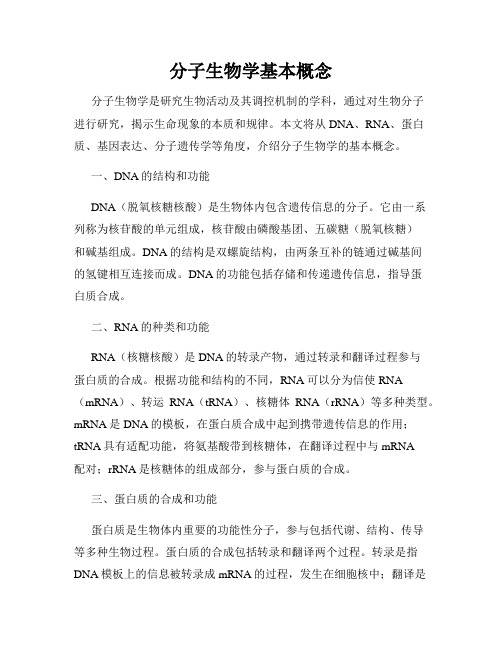
分子生物学基本概念分子生物学是研究生物活动及其调控机制的学科,通过对生物分子进行研究,揭示生命现象的本质和规律。
本文将从DNA、RNA、蛋白质、基因表达、分子遗传学等角度,介绍分子生物学的基本概念。
一、DNA的结构和功能DNA(脱氧核糖核酸)是生物体内包含遗传信息的分子。
它由一系列称为核苷酸的单元组成,核苷酸由磷酸基团、五碳糖(脱氧核糖)和碱基组成。
DNA的结构是双螺旋结构,由两条互补的链通过碱基间的氢键相互连接而成。
DNA的功能包括存储和传递遗传信息,指导蛋白质合成。
二、RNA的种类和功能RNA(核糖核酸)是DNA的转录产物,通过转录和翻译过程参与蛋白质的合成。
根据功能和结构的不同,RNA可以分为信使RNA (mRNA)、转运RNA(tRNA)、核糖体RNA(rRNA)等多种类型。
mRNA是DNA的模板,在蛋白质合成中起到携带遗传信息的作用;tRNA具有适配功能,将氨基酸带到核糖体,在翻译过程中与mRNA配对;rRNA是核糖体的组成部分,参与蛋白质的合成。
三、蛋白质的合成和功能蛋白质是生物体内重要的功能性分子,参与包括代谢、结构、传导等多种生物过程。
蛋白质的合成包括转录和翻译两个过程。
转录是指DNA模板上的信息被转录成mRNA的过程,发生在细胞核中;翻译是指mRNA上的遗传信息被翻译成蛋白质的过程,发生在核糖体中。
蛋白质的功能由其氨基酸序列和三维结构所决定。
四、基因表达的调控基因表达是指基因信息被转录和翻译成蛋白质的过程。
基因表达的调控包括转录调控和转录后调控两个层面。
转录调控是指在转录过程中对基因的调控,包括启动子结构、转录因子结合和染色质结构等因素;转录后调控是指在转录后对mRNA和蛋白质的调控,包括剪接、RNA降解和翻译后修饰等过程。
五、分子遗传学的研究分子遗传学是研究基因及其在遗传过程中的作用机制的学科。
通过分子遗传学的研究,可以揭示基因与表型之间的关系,探究基因突变与遗传病的关联,并对基因工程和基因治疗等领域提供理论基础。
生物课教案:分子生物学的基本概念

生物课教案:分子生物学的基本概念一、引言分子生物学是现代生物学的重要分支之一,其研究对象为生物体内分子层面的结构、功能和相互作用方式。
分子生物学研究所取得的成果不仅促进了生命科学的发展,也为医学、农业和生物工程领域的发展提供了重要支持。
本教案将围绕分子生物学的基本概念展开,包括基本概念、分子结构与功能、分子遗传与表达等几个方面。
二、基本概念1. 分子:分子是物质最基本的组成单位,由原子通过共价键连接而成。
生物体内包含了大量的生物分子,如蛋白质、核酸、多糖和脂质等。
2. 分子结构:分子的结构决定了其功能和性质。
蛋白质是由氨基酸通过肽键连接而成的线性多肽链,核酸是由核苷酸通过磷酸二酯键连接而成的聚合物,多糖是由单糖通过糖苷键连接而成的聚合物,脂质由甘油与脂肪酸通过酯键连接而成。
3. 分子功能:不同类型的生物分子具有不同的功能。
蛋白质在生物体中担任着结构支持、酶催化、运输传递、调节和防御等多种功能;核酸是生物体内的遗传信息载体,参与了基因表达和遗传变异等重要过程;多糖参与细胞识别和黏附、能量储存和结构支持等功能;脂质在细胞膜的结构和功能中起着重要作用。
4. 分子相互作用:不同的生物分子通过相互作用形成生物体内复杂的结构和功能网络。
蛋白质与其他分子通过氢键、离子键、范德华力和疏水相互作用等形成复杂的蛋白质结构;核酸通过碱基配对和骨架相互作用形成DNA的双螺旋结构;蛋白质与核酸之间通过酶作用实现基因的转录和翻译等过程。
三、分子结构与功能1. 蛋白质结构与功能:蛋白质结构包括了四个层次,即原始结构、二级结构、三级结构和四级结构。
原始结构由氨基酸的序列决定,二级结构由氢键作用形成α-螺旋和β-折叠等结构,三级结构由氢键、离子键和疏水力等作用形成立体空间结构,四级结构由多个蛋白质亚基通过非共价键结合而成。
不同的蛋白结构决定了其特定的功能,如酶活性、结构支持或信号传导。
2. 核酸结构与功能:核酸包括DNA和RNA两种类型,它们的基本结构由核苷酸单元组成。
分子生物学基本含义
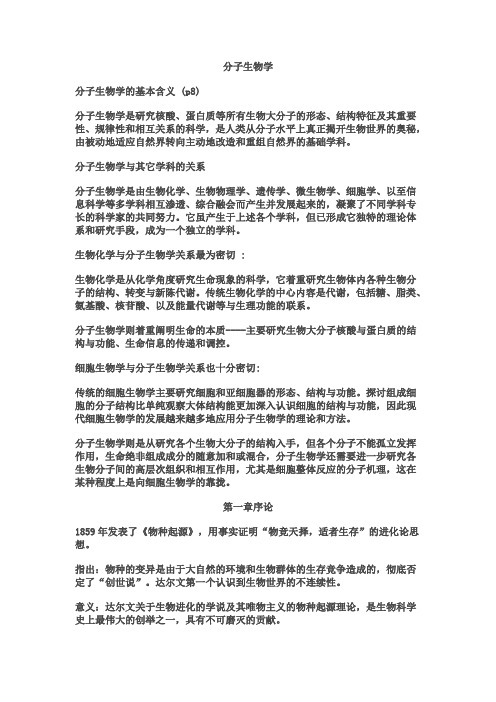
分子生物学分子生物学的基本含义(p8)分子生物学是研究核酸、蛋白质等所有生物大分子的形态、结构特征及其重要性、规律性和相互关系的科学,是人类从分子水平上真正揭开生物世界的奥秘,由被动地适应自然界转向主动地改造和重组自然界的基础学科。
分子生物学与其它学科的关系分子生物学是由生物化学、生物物理学、遗传学、微生物学、细胞学、以至信息科学等多学科相互渗透、综合融会而产生并发展起来的,凝聚了不同学科专长的科学家的共同努力。
它虽产生于上述各个学科,但已形成它独特的理论体系和研究手段,成为一个独立的学科。
生物化学与分子生物学关系最为密切:生物化学是从化学角度研究生命现象的科学,它着重研究生物体内各种生物分子的结构、转变与新陈代谢。
传统生物化学的中心内容是代谢,包括糖、脂类、氨基酸、核苷酸、以及能量代谢等与生理功能的联系。
分子生物学则着重阐明生命的本质----主要研究生物大分子核酸与蛋白质的结构与功能、生命信息的传递和调控。
细胞生物学与分子生物学关系也十分密切:传统的细胞生物学主要研究细胞和亚细胞器的形态、结构与功能。
探讨组成细胞的分子结构比单纯观察大体结构能更加深入认识细胞的结构与功能,因此现代细胞生物学的发展越来越多地应用分子生物学的理论和方法。
分子生物学则是从研究各个生物大分子的结构入手,但各个分子不能孤立发挥作用,生命绝非组成成分的随意加和或混合,分子生物学还需要进一步研究各生物分子间的高层次组织和相互作用,尤其是细胞整体反应的分子机理,这在某种程度上是向细胞生物学的靠拢。
第一章序论1859年发表了《物种起源》,用事实证明“物竞天择,适者生存”的进化论思想。
指出:物种的变异是由于大自然的环境和生物群体的生存竞争造成的,彻底否定了“创世说”。
达尔文第一个认识到生物世界的不连续性。
意义:达尔文关于生物进化的学说及其唯物主义的物种起源理论,是生物科学史上最伟大的创举之一,具有不可磨灭的贡献。
细胞学说细胞学说的建立及其意义德国植物学家施莱登和德国动物学家施旺共同提出:一切植物、动物都是由细胞组成的,细胞是一切动植物的基本单位。
分子生物学课件ppt

转基因技术
转基因技术是将外源基因导入生物体,实现基因的过 表达或补充。转基因技术的关键在于选择合适的载体 和导入方法。
THANKS
感谢观看
基因编辑技术的应用
基因编辑技术在许多领域都有广泛的应用,如罕见病治疗、癌症免疫治疗、农业育种等。 通过基因编辑技术,可以实现对特定基因的敲除、敲入或修饰,以达到治疗或改良的目的 。
基因编辑技术的伦理问题
虽然基因编辑技术具有巨大的潜力,但也引发了伦理和法律等方面的争议。在应用基因编 辑技术时,需要充分考虑伦理和法律问题,确保技术的合理应用和规范发展。
发展趋势
基因组学、蛋白质组学、代谢组学等 多组学研究,跨学科交叉融合,生物 信息学和计算生物学的发展等。
02
分生物学基本概念
基因与DNA
基因
基因是生物体内携带遗传信息的最小 单位,负责编码蛋白质或RNA分子 。
DNA
DNA是生物体的主要遗传物质,由四 种不同的脱氧核苷酸组成,通过特定 的序列排列储存遗传信息。
高通量测序
高通量测序是指一次可以对大量DNA或RNA分子进行序列测定的技术。高通量测序技术极大地提高了 基因组学和转录组学研究的效率,为生物医学研究提供了强大的工具。
04
分子生物学应用
生物医药研究
01
02
03
药物设计与开发
利用分子生物学技术,研 究药物与靶点的相互作用 ,提高药物的疗效和降低 副作用。
分子生物学前沿研究
表观遗传学研究
01
表观遗传学研究
表观遗传学是研究基因表达的调控机制,通过研究DNA甲基化、组蛋
白修饰等机制,揭示基因表达的调控规律,以及环境因素对基因表达的
影响。
02
分子生物学基础

分子生物学基础分子生物学是研究生物分子结构、功能和相互作用的学科,是现代生物学的重要组成部分。
通过对生物分子的研究,可以深入了解细胞的机制、生命的起源和演化,以及疾病的发生和治疗等方面。
本文将介绍分子生物学的基本概念、研究方法和应用领域等。
一、基本概念1. 生物分子:生物体内存在着许多不同种类的分子,如蛋白质、核酸、碳水化合物和脂质等。
这些分子构成了细胞的基本单位,参与了各种生物过程。
2. DNA:脱氧核糖核酸(DNA)是生物体中重要的遗传物质,携带了生物个体遗传信息的蓝图。
DNA由四种碱基(腺嘌呤、鸟嘌呤、胸腺嘧啶和鳞嘌呤)组成,以双螺旋结构存在。
3. RNA:核糖核酸(RNA)是DNA的姐妹分子,具有多种功能。
其中信使RNA(mRNA)通过转录过程将DNA编码的信息转化为蛋白质合成的模板。
4. 蛋白质:蛋白质是生物体内最重要的功能性分子。
它们由氨基酸组成,通过肽键连接成链状结构。
蛋白质不仅构成了细胞的结构,还具有调节代谢、传递信号和催化反应等生物功能。
二、研究方法1. 分子克隆:分子克隆是指将DNA或RNA片段插入载体(如质粒)中,通过细菌或其他生物体来复制这些分子片段。
这一技术可以用于生物工程、基因治疗等领域。
2. PCR:聚合酶链反应(PCR)是一种体外扩增DNA片段的方法。
它利用特定引物和DNA聚合酶,通过一系列温度循环反复合成DNA的同源链,扩增目标序列。
3. 凝胶电泳:凝胶电泳是一种常用的分离生物分子的方法。
通过在凝胶中施加电场,根据分子的大小和电荷来分离DNA、RNA和蛋白质等。
4. 聚合酶链式反应(PCR):PCR是一种常用的体外扩增DNA片段的方法。
通过引物的特异性与DNA片段的互补性,聚合酶可以复制和扩增模板DNA。
三、应用领域1. 基因工程:分子生物学的发展为基因工程提供了基础。
通过基因重组、转基因等技术,可以克隆和改造DNA,生产重组蛋白质、植物转基因等。
2. 遗传疾病诊断:分子生物学的方法在遗传疾病的诊断中起着关键作用。
分子生物学

对蛋白质结构与功能的进一步认识
1956-58年Anfinsen和White根据对酶 蛋白的变性和复性实验,提出蛋白质的 三维空间结构是由其氨基酸序列来确定 的。1958年Ingram证明正常的血红蛋白 与镰刀状细胞溶血症病人的血红蛋白之 间,亚基的肽链上仅有一个氨基酸残基 的差别,使人们对蛋白质一级结构影响 功能有了深刻的印象。与此同时,对蛋 白质研究的手段也有改进,1969年Weber 开始应用SDS-聚丙烯酰胺凝胶电泳测定 蛋白质分子量;
(二)、现代分子生物学的建立和发展阶段
这一阶段是从50年代初到70年代初, 以1953年Watson和Crick提出的DNA双螺 旋结构模型作为现代分子生物学诞生的 里程碑开创了分子遗传学基本理论建立 和发展的黄金时代。DNA双螺旋发现的最 深刻意义在于:确立了核酸作为信息分 子的结构基础;提出了碱基配对是核酸复 制、遗传信息传递的基本方式;从而最 后确定了核酸是遗传的物质基础,为认 识核酸与
蛋白质的关系及其在生命中的作用打下了 最重要的基础。在此期间的主要进展包 括:
遗传信息传递中心法则的建立
在发现DNA双螺旋结构同时,Watson 和Crick就提出DNA复制的可能模型。其 后在1956年A.Kornbery首先发现DNA聚合 酶;1958年Meselson及Stahl用同位素标 记和超速离心分离实验为DNA半保留模型 提出了证明;1968年Okazaki(冈畸)提 出DNA不连续复制模型;1972年证实了 DNA复制
S.Furbery等的X-线衍射分析阐明了核苷酸 并非平面的空间构像,提出了DNA是螺旋 结构;1948-1953年Chargaff等用新的层 析和电泳技术分析组成DNA的碱基和核苷 酸量,积累了大量的数据,提出了DNA碱 基组成A=T、G=C的Chargaff规则,为碱 基配对的DNA结构认识打下了基础。
分子生物学知识点整理

分子生物学知识点整理1.基本分子生物学概念:基因、DNA、RNA和蛋白质是分子生物学的基本概念。
基因是一段DNA序列,负责编码产生RNA和蛋白质。
DNA是脱氧核糖核酸,由含有遗传信息的碱基序列组成。
RNA是核糖核酸,负责将DNA的信息转录成具体蛋白质的制作指令。
蛋白质是由氨基酸组成的大分子,负责细胞的结构和功能。
2.DNA的结构:DNA是双螺旋结构,由两条互相缠绕的链组成,这两条链通过碱基之间的氢键相互连接。
DNA的碱基包括腺嘌呤(A)、胸腺嘧啶(T)、鸟嘌呤(G)和胞嘧啶(C)。
3.DNA复制:DNA复制是细胞分裂的过程中,DNA双链被复制为两条相同的DNA双链。
这是生命的一个基本过程,确保每个新细胞都有完整的遗传信息。
DNA复制是由DNA聚合酶酶进行的,它们能够将新的碱基加到原有的DNA链上。
4.转录:转录是将DNA的信息复制成RNA的过程。
这个过程包括三个步骤:启动、延伸和终止。
在转录开始时,RNA聚合酶酶会识别DNA链上一个特定的启动位点,然后沿着DNA模板链向前延伸合成RNA链。
转录的终止是由特定的序列标志着的,一旦被识别,RNA聚合酶酶就会停止合成RNA。
5.翻译:翻译是将RNA的信息转化成蛋白质的过程。
这个过程涉及到tRNA和核糖体的作用。
tRNA具有与特定氨基酸结合的能力,并根据mRNA 模板上的密码子序列,将氨基酸逐个带入核糖体中合成蛋白质。
6.基因调控:基因调控是细胞内基因表达的调控机制,使细胞能够根据需要调整哪些基因的表达,以适应不同的环境条件。
这包括启动子、转录因子和RNA干扰等机制。
7.基因突变和遗传变异:基因突变是指在DNA链上发生的改变,可能导致蛋白质的结构和功能的改变。
遗传变异包括基因重组、基因扩增和基因缺失等,能够产生新的基因组和生物特征。
8.PCR:聚合酶链式反应(PCR)是一种用于扩增DNA片段的技术。
它涉及到短的引物,用于界定所需扩增的DNA片段,然后通过多次的加热和冷却循环,DNA被不断复制,产生大量的DNA片段。
公共基础知识分子生物学基础知识概述
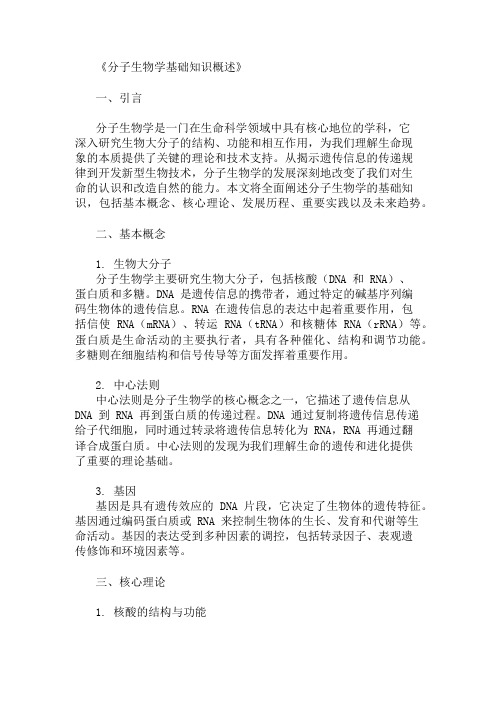
《分子生物学基础知识概述》一、引言分子生物学是一门在生命科学领域中具有核心地位的学科,它深入研究生物大分子的结构、功能和相互作用,为我们理解生命现象的本质提供了关键的理论和技术支持。
从揭示遗传信息的传递规律到开发新型生物技术,分子生物学的发展深刻地改变了我们对生命的认识和改造自然的能力。
本文将全面阐述分子生物学的基础知识,包括基本概念、核心理论、发展历程、重要实践以及未来趋势。
二、基本概念1. 生物大分子分子生物学主要研究生物大分子,包括核酸(DNA 和 RNA)、蛋白质和多糖。
DNA 是遗传信息的携带者,通过特定的碱基序列编码生物体的遗传信息。
RNA 在遗传信息的表达中起着重要作用,包括信使 RNA(mRNA)、转运 RNA(tRNA)和核糖体 RNA(rRNA)等。
蛋白质是生命活动的主要执行者,具有各种催化、结构和调节功能。
多糖则在细胞结构和信号传导等方面发挥着重要作用。
2. 中心法则中心法则是分子生物学的核心概念之一,它描述了遗传信息从DNA 到 RNA 再到蛋白质的传递过程。
DNA 通过复制将遗传信息传递给子代细胞,同时通过转录将遗传信息转化为 RNA,RNA 再通过翻译合成蛋白质。
中心法则的发现为我们理解生命的遗传和进化提供了重要的理论基础。
3. 基因基因是具有遗传效应的 DNA 片段,它决定了生物体的遗传特征。
基因通过编码蛋白质或 RNA 来控制生物体的生长、发育和代谢等生命活动。
基因的表达受到多种因素的调控,包括转录因子、表观遗传修饰和环境因素等。
三、核心理论1. 核酸的结构与功能DNA 具有双螺旋结构,由两条反向平行的脱氧核苷酸链组成,通过碱基互补配对原则结合在一起。
DNA 的结构稳定性为遗传信息的准确传递提供了保障。
RNA 则具有多种结构形式,包括单链、双链和环状等,不同的 RNA 分子在生命活动中发挥着不同的功能。
2. 蛋白质的结构与功能蛋白质的结构决定了其功能。
蛋白质的一级结构是指氨基酸的线性序列,二级结构包括α-螺旋和β-折叠等,三级结构是由二级结构进一步折叠形成的三维结构,四级结构是由多个亚基组成的蛋白质复合物。
《分子生物学基础》课件

近年来,随着基因组学、蛋白 质组学和生物信息学等新兴领 域的发展,分子生物学的研究 范围和应用领域不断扩大和深 化。
目前,分子生物学已经成为生 命科学领域中最重要的学科之 一,对于未来的生命科学研究 和新技术的开发具有重要的推 动作用。
02
分子生物学基本概念
基因与DNA
基因是生物体遗传信息的载体, 由DNA分子组成。
DNA是双螺旋结构,由四种不 同的脱氧核苷酸组成,通过碱基
配对维持其稳定性。
DNA复制是遗传信息传递的关 键过程,通过半保留复制确保遗
传信息的准确传递。
蛋白质与酶
蛋白质是生物体的重要组成成分,具有多种结构 和功能。
酶是生物体内具有催化功能的蛋白质,能够加速 化学反应的速率。
酶的活性受多种因素调节,包括温度、pH值、抑 制剂和激活剂等。
分子生物学具有跨学科的特点,涉及到化学、物理学、生物学等多个领域的知识。
分子生物学的研究方法和技术手段多种多样,包括基因组学、蛋白质组学、生物信 息学等。
分子生物学的重要性
分子生物学是现代生物学的核心学科之一,对于理解 生命的本质和机制具有重要意义。
分子生物学在医学、农业、工业等领域有着广泛的应 用,对于疾病的诊断和治疗、新药的研发和农业生产
VS
详细描述
干细胞研究涉及胚胎干细胞和成体干细胞 等多种类型。在再生医学中,通过诱导干 细胞定向分化或利用干细胞的旁分泌效应 ,可以实现受损组织的修复和再生。目前 ,干细胞治疗已在多种疾病中取得初步成 效,如糖尿病、帕金森病等。
表观遗传学在疾病研究中的应用
总结词
表观遗传学是研究基因表达水平上遗传信息的变异和传递的学科,与疾病的发生和发展 密切相关。
详细描述
分子生物学考点总结

02 D. 细胞分裂
03
2. 在分子生物学中,DNA的哪种特性使其成为遗传
信息的载体?
选择题
01
A. 稳定性
02
B. 可复制性
03
C. 可变性
04
D. 可转录性
填空题
1. DNA的基本组成单位是________。 2. ________是指DNA分子中碱基对的排列顺序。
3. ________是指DNA分子中特定的碱基序列,可以控制蛋白质的合成。
率和品质。
生物农药
03
利用微生物或其代谢产物,开发高效、低毒、低残留的生物农
药,替代化学农药。
工业生物技术
生物催化
利用酶或其他生物催化剂,在温和条件下进行有机合成和降解, 降低能耗和环境污染。
生物材料
利用生物分子或微生物,制备具有特殊性能的生物材料,如可降 解塑料、生物纤维等。
生物制药
利用分子生物学技术,生产高纯度、高质量的药物,降低制药成 本和提高生产效率。
受体作用
细胞受体能识别信号分子并与其结合,进而触发一系 列的信号转导反应。
信号转导途径
信号转导途径是指信号分子与受体结合后,通过一系 列的信号传递过程,最终导致细胞反应的过程。
基因表达与调控
基因表达
基因表达是指基因经过转录和翻译过程,将遗传信息转化为具有功能的蛋白质的过程。
基因调控
基因调控是指对基因表达的启动、维持和终止过程进行调节和控制,以实现对细胞功能和代谢活 动的精细调节。
蛋白质组学分析
蛋白质组学
研究细胞中所有蛋白质的表达、修饰和功能情况。
蛋白质相互作用分析
通过实验手段研究蛋白质之间的相互作用关系,揭示蛋白质的功能网络。
分子生物学概述
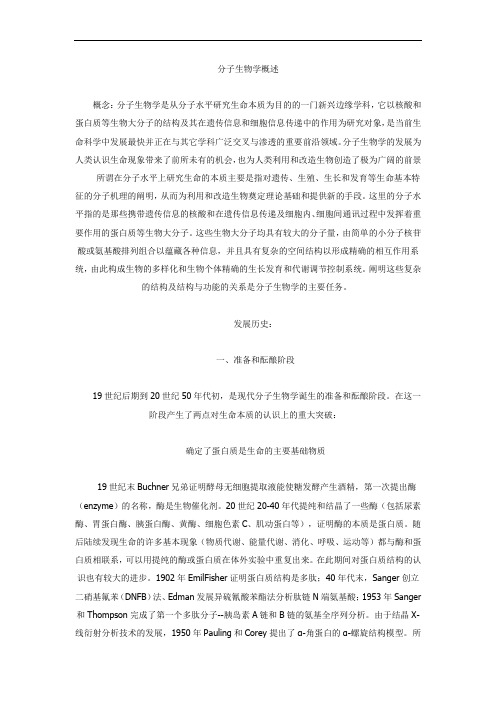
分子生物学概述概念:分子生物学是从分子水平研究生命本质为目的的一门新兴边缘学科,它以核酸和蛋白质等生物大分子的结构及其在遗传信息和细胞信息传递中的作用为研究对象,是当前生命科学中发展最快并正在与其它学科广泛交叉与渗透的重要前沿领域。
分子生物学的发展为人类认识生命现象带来了前所未有的机会,也为人类利用和改造生物创造了极为广阔的前景所谓在分子水平上研究生命的本质主要是指对遗传、生殖、生长和发育等生命基本特征的分子机理的阐明,从而为利用和改造生物奠定理论基础和提供新的手段。
这里的分子水平指的是那些携带遗传信息的核酸和在遗传信息传递及细胞内、细胞间通讯过程中发挥着重要作用的蛋白质等生物大分子。
这些生物大分子均具有较大的分子量,由简单的小分子核苷酸或氨基酸排列组合以蕴藏各种信息,并且具有复杂的空间结构以形成精确的相互作用系统,由此构成生物的多样化和生物个体精确的生长发育和代谢调节控制系统。
阐明这些复杂的结构及结构与功能的关系是分子生物学的主要任务。
发展历史:一、准备和酝酿阶段19世纪后期到20世纪50年代初,是现代分子生物学诞生的准备和酝酿阶段。
在这一阶段产生了两点对生命本质的认识上的重大突破:确定了蛋白质是生命的主要基础物质19世纪末Buchner兄弟证明酵母无细胞提取液能使糖发酵产生酒精,第一次提出酶(enzyme)的名称,酶是生物催化剂。
20世纪20-40年代提纯和结晶了一些酶(包括尿素酶、胃蛋白酶、胰蛋白酶、黄酶、细胞色素C、肌动蛋白等),证明酶的本质是蛋白质。
随后陆续发现生命的许多基本现象(物质代谢、能量代谢、消化、呼吸、运动等)都与酶和蛋白质相联系,可以用提纯的酶或蛋白质在体外实验中重复出来。
在此期间对蛋白质结构的认识也有较大的进步。
1902年EmilFisher证明蛋白质结构是多肽;40年代末,Sanger创立二硝基氟苯(DNFB)法、Edman发展异硫氰酸苯酯法分析肽链N端氨基酸;1953年Sanger 和Thompson完成了第一个多肽分子--胰岛素A链和B链的氨基全序列分析。
分子生物学基础

分子生物学基础分子生物学是现代生命科学领域中最具活力和前景的学科之一。
它以分子为研究基础,探索生命的奥秘,揭示生物体的生命活动规律。
本文将介绍分子生物学的基础知识,包括DNA、RNA、蛋白质和细胞信号转导等。
一、DNA:生命的遗传密码DNA,即脱氧核糖核酸(Deoxyribonucleic Acid),是生物体的遗传物质,负责储存和传递遗传信息。
DNA由四种碱基组成:腺嘌呤(A)、胸腺嘧啶(T)、鸟嘌呤(G)和胞嘧啶(C)。
这些碱基按照特定的顺序排列,形成一串串的密码子,指导细胞合成相应的蛋白质。
DNA的复制是生命延续的基础。
在分裂间期,DNA双链解开,形成单链模板,根据碱基互补配对原则合成新的DNA链。
在分裂期,DNA双链进一步解开,形成两条单链染色体,分配到两个子细胞中。
二、RNA:翻译过程中的重要角色RNA,即核糖核酸(Ribonucleic Acid),是DNA转录的产物,也是蛋白质合成的中间产物。
RNA分为三种:mRNA、tRNA和rRNA。
mRNA 是编码蛋白质的RNA,携带由DNA转录而来的信息;tRNA是转运RNA,负责将氨基酸转运到核糖体上;rRNA是核糖体RNA,与蛋白质一起构成核糖体,为蛋白质合成提供场所。
在翻译过程中,mRNA根据密码子的顺序指导氨基酸合成多肽链。
tRNA 将氨基酸转运到核糖体上,按照mRNA的密码子顺序依次连接成肽链。
rRNA与蛋白质构成核糖体,为翻译过程提供场所和能量。
三、蛋白质:生命活动的执行者蛋白质是生物体内最重要的分子之一,是生命活动的主要执行者。
蛋白质由氨基酸组成,具有特定的空间构象和功能活性。
不同的蛋白质具有不同的结构和功能,如酶、激素、抗体、载体等。
蛋白质的合成以mRNA为模板,经过翻译过程合成多肽链。
多肽链经过折叠和修饰后形成具有特定结构和功能的蛋白质。
蛋白质的合成和降解受到严格的调控,以确保生命活动的正常进行。
四、细胞信号转导:细胞通讯的基础细胞信号转导是指细胞间通过传递信号分子来实现信息交流和沟通的过程。
分子生物学的基本概念

分子生物学的基本概念引言分子生物学是研究生物体中分子结构和功能的科学领域。
它通过研究和理解生物大分子(如DNA、RNA和蛋白质)以及它们的相互作用来揭示生命的基本原理。
本文将介绍一些分子生物学的基本概念。
DNADNA(脱氧核糖核酸)是一种储存生物信息的长链分子。
它由四种不同的碱基(腺嘌呤、胸腺嘧啶、鸟嘌呤和胞嘧啶)组成。
DNA的两条链以螺旋的形式相互缠绕,形成了著名的双螺旋结构。
DNA携带了生物体的遗传信息,指导了细胞的生长、发育和功能。
RNARNA(核糖核酸)也是一种核酸分子,它在细胞中担任多种重要角色。
与DNA不同,RNA是单链分子,由四种碱基(腺嘌呤、尿嘧啶、胸腺嘧啶和胞嘧啶)组成。
RNA可以将DNA中的遗传信息转录成蛋白质,这个过程被称为转录。
除了转录,RNA还参与其他生物过程,如蛋白质合成、基因表达和调控等。
蛋白质蛋白质是生物体中最重要的分子之一,它在细胞中发挥着多种功能。
蛋白质由氨基酸组成,不同的氨基酸序列决定了蛋白质的结构和功能。
蛋白质可以催化生化反应、支持细胞结构、传递信号和参与免疫系统等。
蛋白质的功能多样化,对生命过程至关重要。
基因基因是DNA分子的一个片段,它包含了一个或多个编码蛋白质的遗传信息。
基因是遗传物质在子代之间传递的基本单位。
基因通过蛋白质的合成来实现其功能,蛋白质的合成过程被称为翻译。
基因的变异和表达调控是生物体进化和发育的关键因素。
分子生物学技术随着科技的进步,许多分子生物学技术被开发出来,用于研究和探索生命的奥秘。
其中一些常用的技术包括PCR(聚合酶链式反应),DNA测序和基因编辑等。
这些技术的应用有助于加深我们对于分子生物学的理解,并为医学、生物工程和农业领域的发展提供了强有力的工具。
结论分子生物学的基本概念涵盖了DNA、RNA、蛋白质、基因和相关技术。
通过研究这些基本概念,我们可以更好地理解生物体的结构和功能,并推动生命科学的发展。
分子生物学的进展对于医学、农业和生物工程等领域具有重要意义。
分子生物学 -绪论
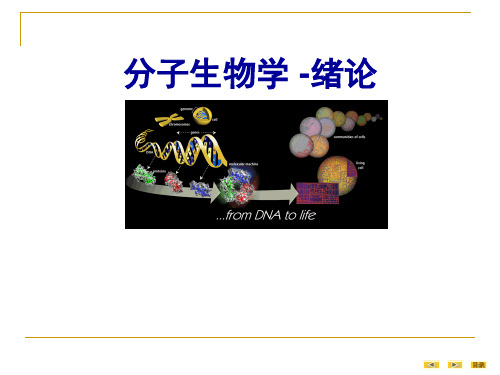
生物化学与分子生物学
第22章:基因结构与功能分析2h 第23章:癌基因、肿瘤抑制基因 与生长因子2h 第24章:疾病相关基因的克隆 第25章:基因诊断与基因治疗
从而逐步完善了对DNA复制机理认识。
目录
同时先后发现依赖于DNA的RNA聚合酶及RNADNA杂交实验证明了mRNA与DNA序列互补,逐 步阐明RNA转录合成的机理。
与此同时认识到蛋白质是接受RNA遗传信息而合 成。
1950年代发现微粒体是蛋白质合成场所;
1957年首先分离出tRNA,并提出了其在蛋白质
目录
医学分子生物学研究内容:
1、研究人体发育、分化和衰老的分子生物学基础 2、细胞增殖调控的分子基础 3、人体三大调控系统(神经、内分泌、免疫)的
分子生物学基础 4、基因的结构异常或调控异常与疾病发生发展之
间关系 5、应用分子生物学理论和技术体系开展疾病的基
因诊断和基因治疗、生物制药及卫生防疫。
讲授内容
目录
分子生物学是生物化学、生物物理学、遗传学、 微生物学、细胞生物学等多学科相互渗透、综合 融会而产生并发展起来的。生命活动的一致性, 是生物学范围内所有学科在分子水平上的统一。
目录
分子生物学的延伸
分ቤተ መጻሕፍቲ ባይዱ生物学已经渗透到生物学的几乎所有领域 分子生物学已经成为生命科学领域的前沿学科
分子结构生物学 分子发育生物学 分子神经生物学 分子育种学 分子肿瘤学
合成中转运氨基酸功能的假说;
目录
1961年观察到蛋白质合成过程中mRNA与核糖 体结合;同期科学工作者还破译了合成蛋白质的遗 传密码,并在随后研究发现遗传密码具有通用性,
医学分子生物学基础

基因传递
2
基因编辑
3
应用领域
将正常基因导入患者的细胞
利用基因编辑技术来修复或
基因治疗在癌症、遗传病和
以治疗遗传病。
修改基因。
传染病等领域有广泛的应用。
细胞信号转导的基本过程
信号接受
信号转导
细胞利用受体来感知外部信号分子。
信号分子通过复杂的传导途径传递到内部。
效应
负反馈机制
信号传导最终导致细胞内的特定生物效应。
细胞外信号通过信号通路调控基因表达。
组蛋白修饰调节染色质的结构和功能。
遗传信息的传递和遗传变异
遗传信息传递
遗传变异
遗传模式
DNA复制和细胞分裂保证遗传信息
突变、重组和其他机制导致个体之
染色体上基因的传递遵循不同的遗
传递给下一代。
间的遗传差异。
传模式。
基因组学的基本概念和技术
1
基因组测序
测定生物体基因组的顺序和结构。
RNA分子。
4
修复和突变
修复机制和突变是DNA所特有的生物学过程。
RNA的结构与功能
信使RNA (mRNA)
转运RNA (tRNA)
核糖体RNA (rRNA)
mRNA将DNA储存的遗传信息转录
tRNA将氨基酸运输到正在合成的
rRNA是蛋白质合成的重要组成部
成蛋白质。
蛋白质链上。
分。
蛋白质的合成与调控
基因组注释
2
分析和解释基因组中的基因和非编码的序列。
3
基因组变异和关联分析
寻找基因组中与特定特征和疾病相关的变异。
基因变异的检测与诊断
遗传测试
诊断方法
个性化治疗
- 1、下载文档前请自行甄别文档内容的完整性,平台不提供额外的编辑、内容补充、找答案等附加服务。
- 2、"仅部分预览"的文档,不可在线预览部分如存在完整性等问题,可反馈申请退款(可完整预览的文档不适用该条件!)。
- 3、如文档侵犯您的权益,请联系客服反馈,我们会尽快为您处理(人工客服工作时间:9:00-18:30)。
[1]The Shine-Dalgarno sequence(AGGAGG), proposed by Australianscientists John Shine and Lynn Dalgarno,[1] is a ribosomal binding site located upstream of the start codon AUG. It is a consensus sequence that helps recruit the ribosome to the mRNA to initiate protein synthesis by aligning it with the start codon. The complementary sequence (CCUCCU), is called the anti-Shine-Dalgarno sequence and is located at the 3' end of the 16S rRNA in the ribosome.Mutations in the Shine-Dalgarno sequence can reduce translation. This reduction is due to a reduced mRNA-ribosome pairing efficiency, as evidenced by the fact that complementary mutations in the anti-Shine-Dalgarno sequence can restore translation.When the Shine-Dalgarno sequence and the anti-Shine-Dalgarno sequence pair, the translation initiation factors IF2-GTP, IF1, IF3, as well as the initiator tRNA fMet-tRNA(fMET) are recruited to the ribosome.Shine-Dalgarno sequence vs. ribosomal S1 protein in Gram-negative bacteria, however, Shine-Dalgarno sequence presence is not obligatory for ribosome to locate initiator codon, since deletion of anti-Shine-Dalgarno sequence from 16S rRNA doesn't lead to translation initiation at non-authentic sites.Moreover, numerous prokaryotic mRNAs don't possess Shine-Dalgarno sequences at all. What principally attracts ribosome to mRNA initiation region is apparently ribosomal protein S1, which binds to AU-rich sequences found in many prokaryotic mRNAs 15-30 nucleotides upstream of start-codon. It should be noted, that S1 is only present in Gram-negative bacteria, being absent from Gram-positive species.SD序列(16S互补区)是位于原核生物mRNA 起始密码子(AUG)上游5~10个核苷酸处,一段富含嘌呤的序列。
其与核糖体小亚基中的16S rRNA的3’末端互补配对,促进mRNA 的翻译。
[2]ORF:An open reading frame (ORF) is a portion of a gene’s sequencethat contains a sequence of bases, uninterrupted by stop sequences, that could potentially encode a protein. When a new gene is identified and its DNA sequence deciphered, it is still unclear what its corresponding protein sequence is. This is because, in the absence ofany other knowledge, the DNA sequence can be translated or read in six possible reading frames (three for each strand,corresponding to three different start positions for the first codon). ORF identification involves scanning each of the six reading frames and determining which one(s) contains a stretch of DNA sequence bounded by a start and stop codon, yet containing no start or stop codons within it; a sequence meeting these conditions could correspond to the actual single product of the gene. The identification of an ORF provides the first evidence that a new sequence of DNA is part or all of a gene encoding for a particular protein.开放性阅读框架是结构基因上一段从起始密码子至终止密码子的核苷酸序列,其编码一个多肽或蛋白质。
通过ORF的检测识别可以判断一条新克隆的DNA序列是否是一个完整的基因。
[3]The blue-white screen is a screening technique that allows for thedetection of successful ligations in vector-based gene cloning. DNA of interest is ligated into a vector. The vector is then transformed into competent cell (bacteria). The competent cells are grown in the presence of X-gal. If the ligation was successful, the bacterial colony will be white; if not, the colony will be blue. This technique allows for the quick and easy detection of successful ligation. β-galactosidase is a protein encoded by the lacZ gene of the lac operon, and it exists as a homotetramer in its active state. However, a mutant β-galactosidase derived from the M15 strain of E. coli has its N-terminal residues 11—41 deleted and this mutant, the ω-peptide, is unable to form a tetramer and is inactive. This mutant form of protein however may return fully to its active tetrameric state in the presence of an N-terminal fragment of the protein, the α-peptide.The rescue of function of the mutant β-galactosidase by the α-peptide is called α-complementation.In this method of screening, the host E. coli strain carries the lacZ deletion mutant (lacZΔM15} which contains the ω-peptide, while the plasmids used carry the lacZα sequence which encodes the first 59 residues of β-galactosidase, the α-peptide. Neither are functional by themselves.However, when the two peptides are expressed together, as when aplasmid containing the lacZα sequence is transformed int o a lacZΔM15 cells, they form a functional β-galactosidase enzyme.The blue/white screening method works by disrupting this α-complementation process. The plasmid carries within the lacZα sequence an internal multiple cloning site (MCS). This MCS within the lacZα sequence can be cut by restriction enzymes so that the foreign DNA may be inserted within the lacZα gene, thereby disrupting the gene and thus production of α-peptide. Consequently, in cells containing the plasmid with an insert, no functional β-galactosidase may be formed.The presence of an active β-galactosidase can be detected by X-gal, a colourless analog of lactose that may be cleaved by β-galactosidase to form 5-bromo-4-chloro-indoxyl, which then spontaneously dimerizes and oxidizes to form a bright blue insoluble pigment 5,5'-dibromo-4,4'-dichloro-indigo. This results in a characteristic blue colour in cells containing a functional β-galactosidase. Blue colonies therefore show that they may contain a vector with an uninterrupted lacZα (therefor e no insert), while white colonies, where X-gal is not hydrolyzed, indicate the presence of an insert in lacZα which disrupts the formation of an active β-galactosidase.蓝白斑筛选是一种基因工程常用的重组菌筛选方法。
